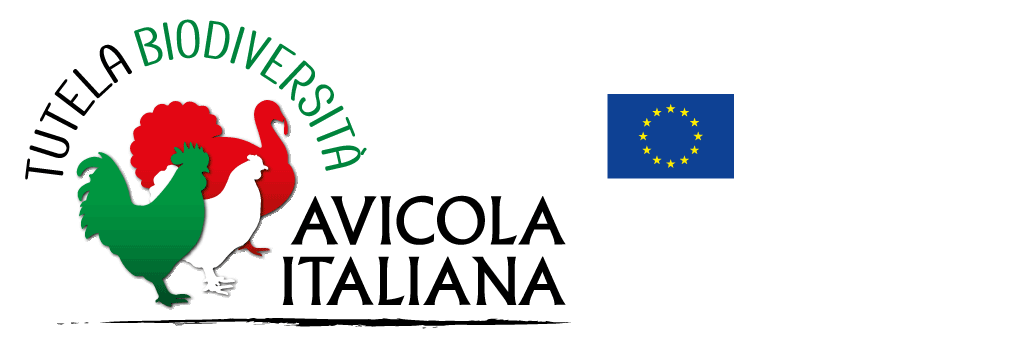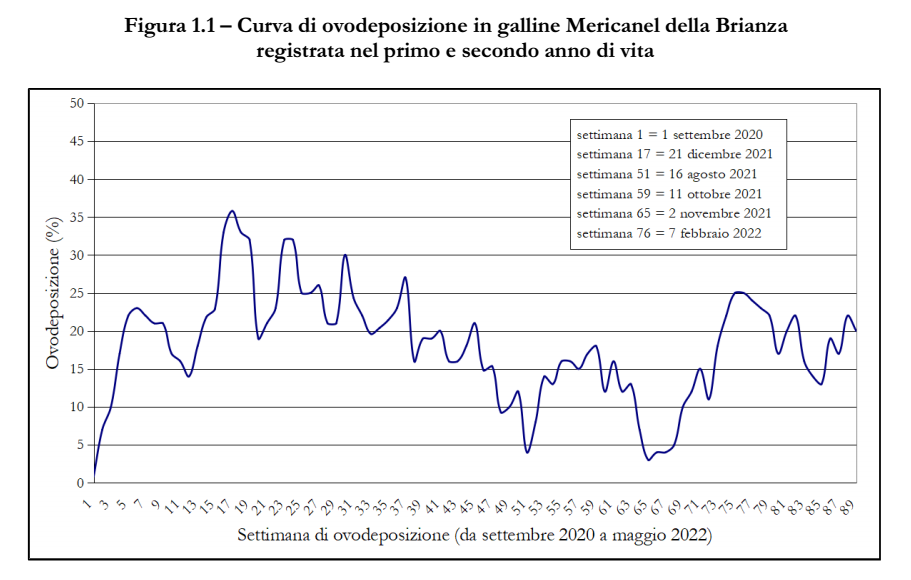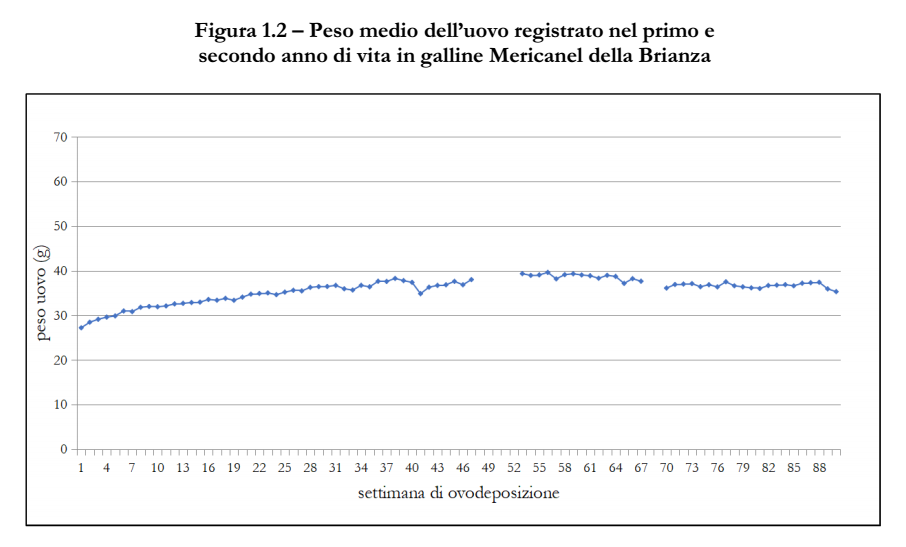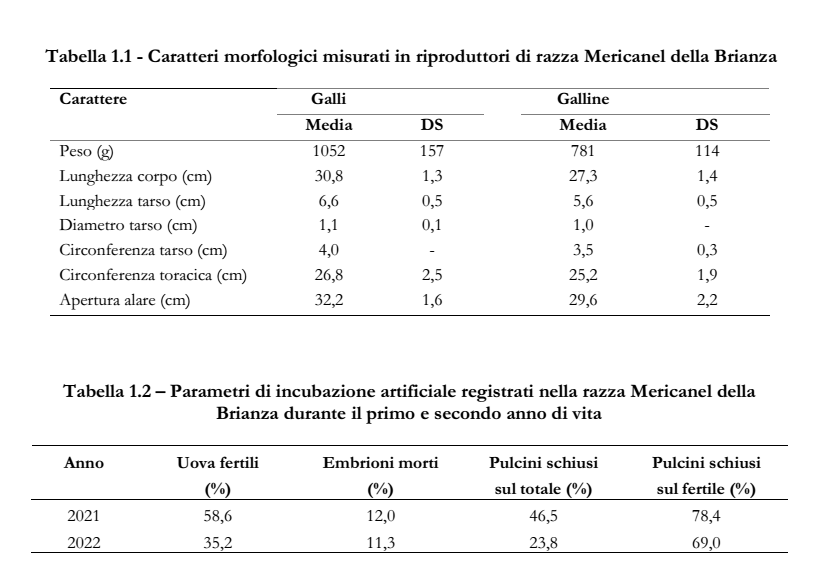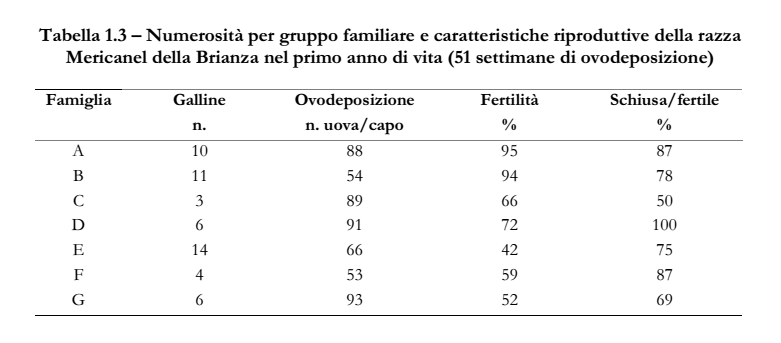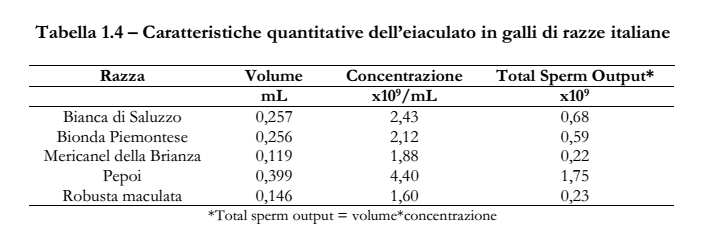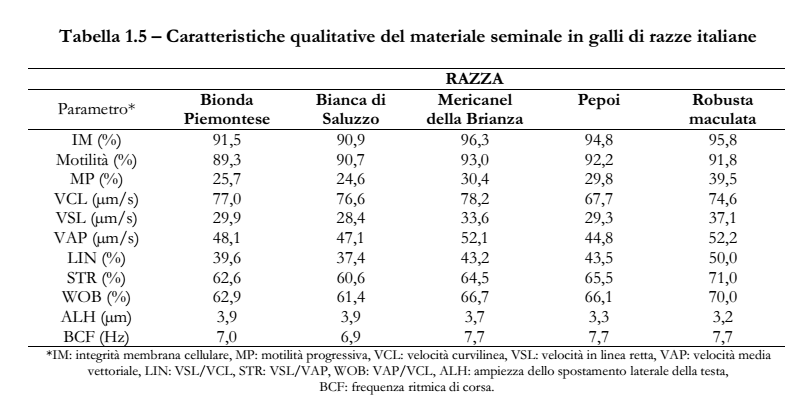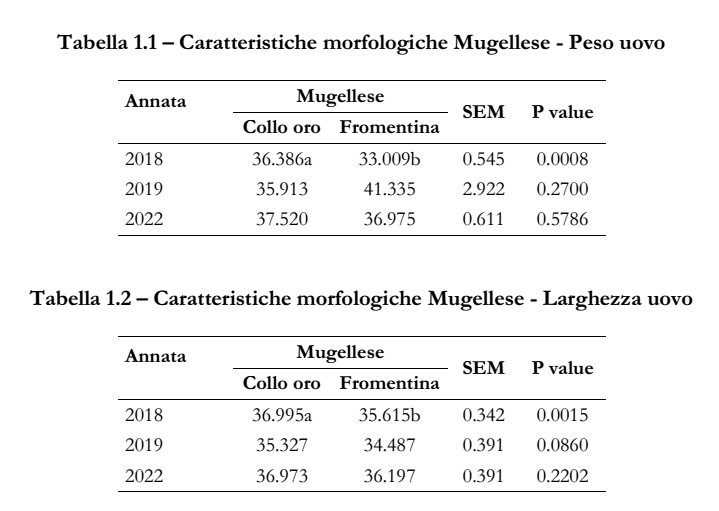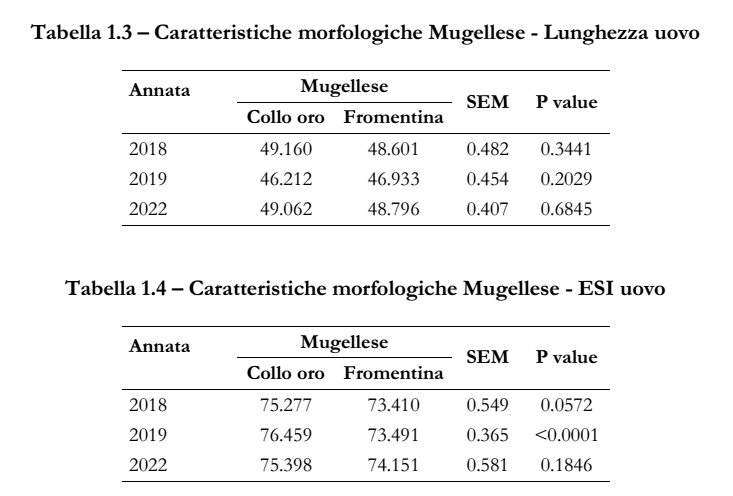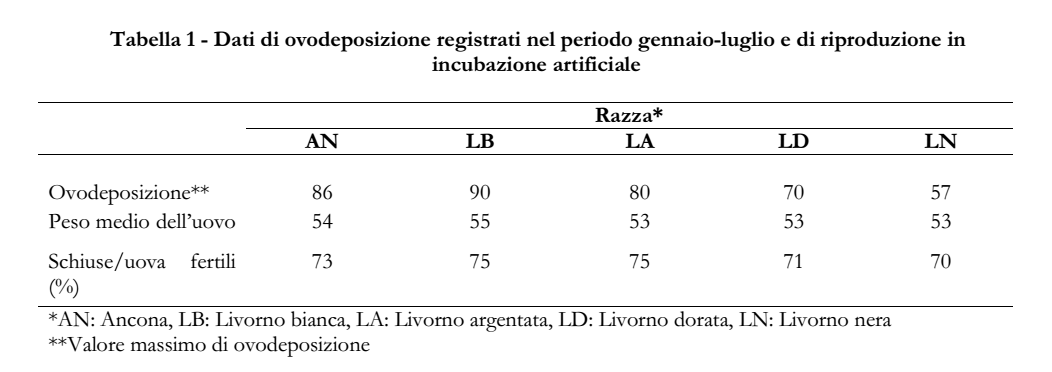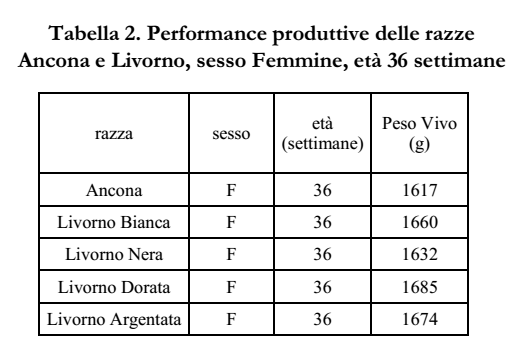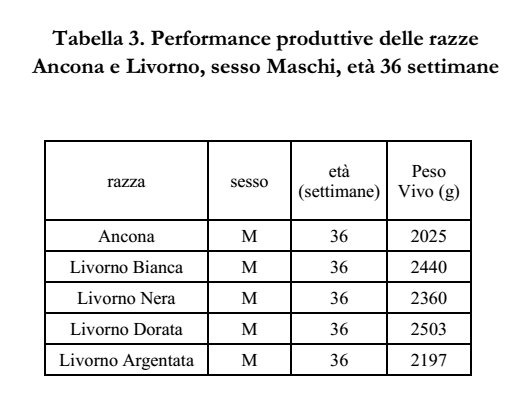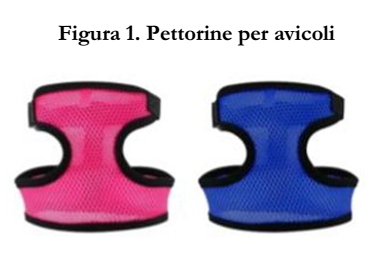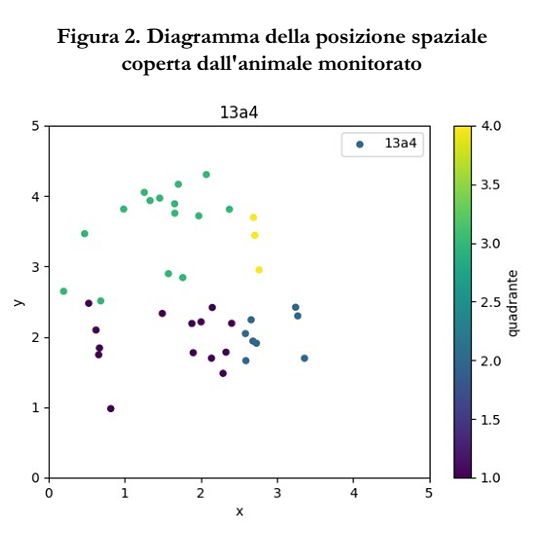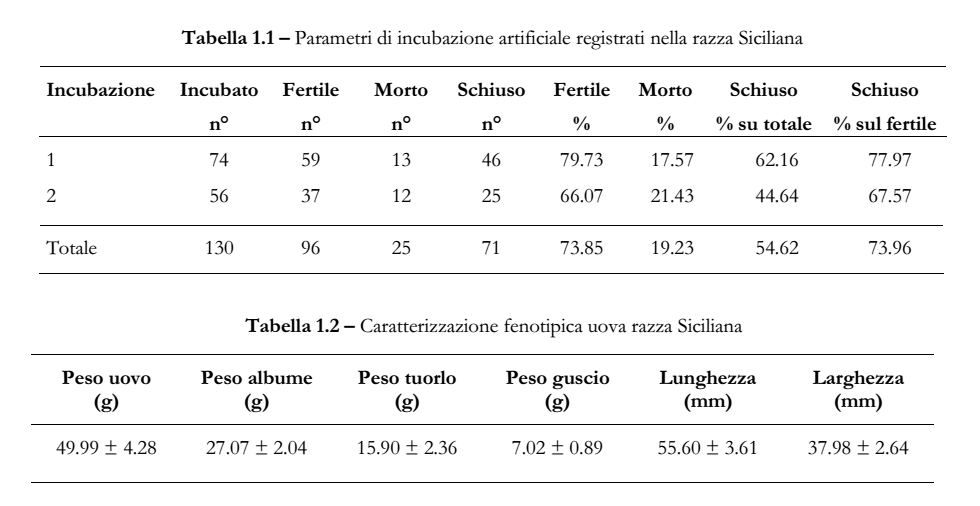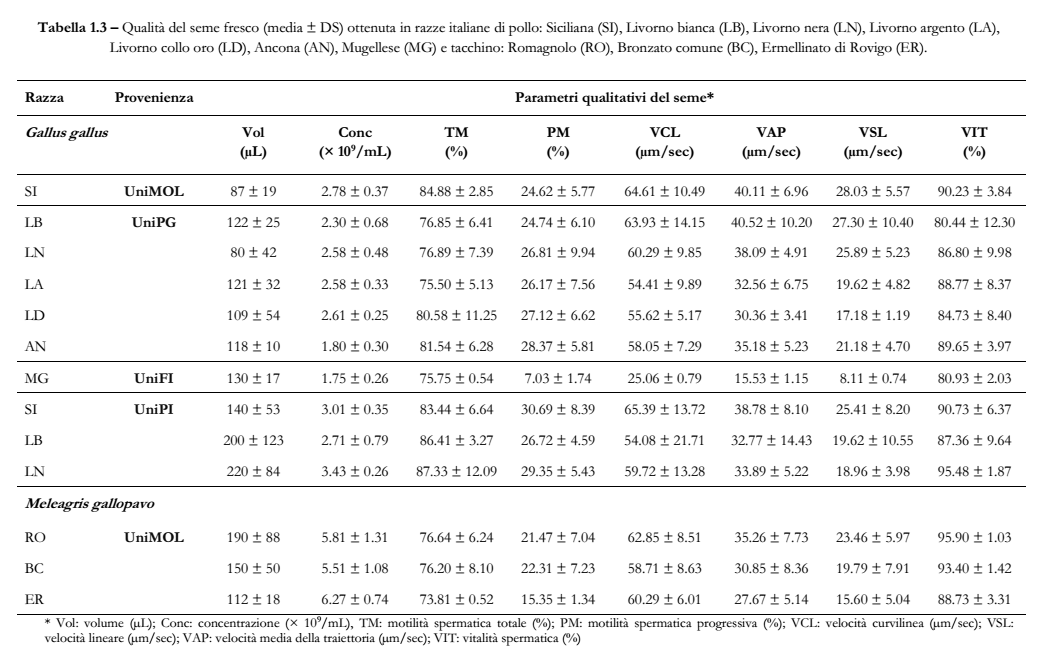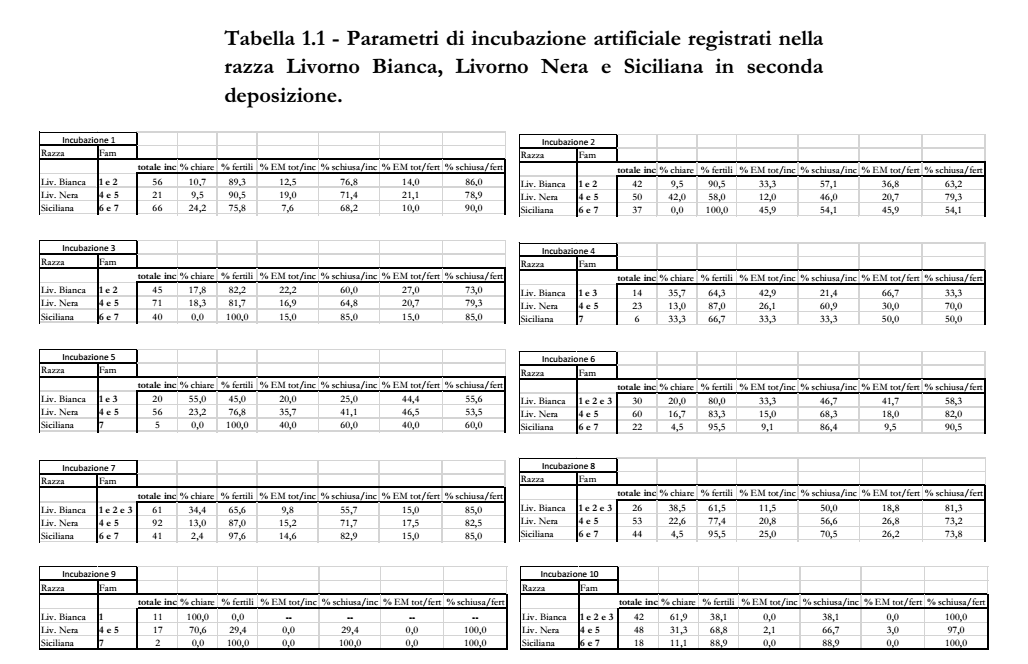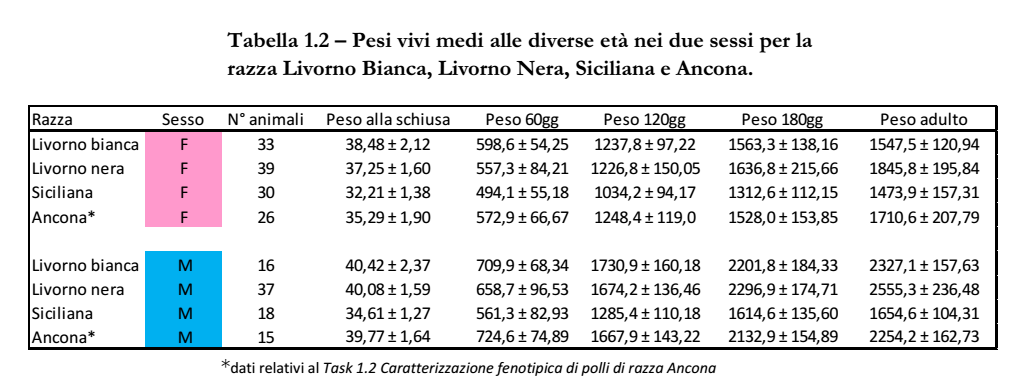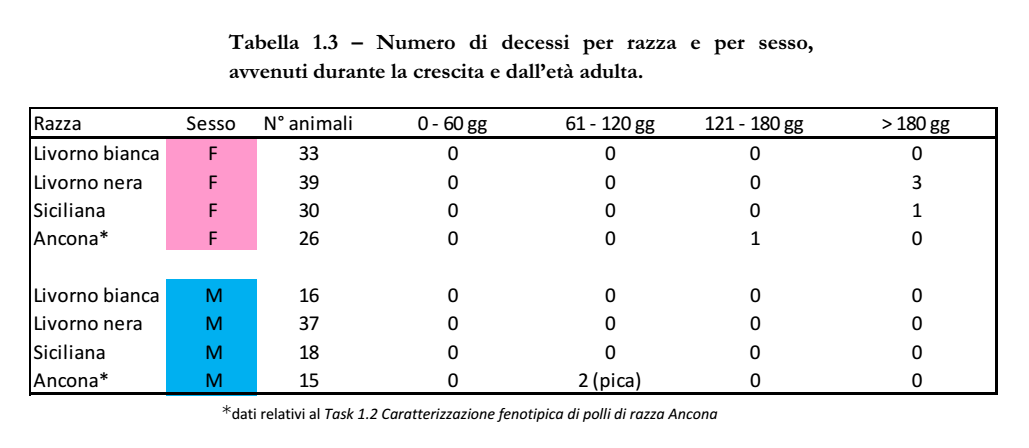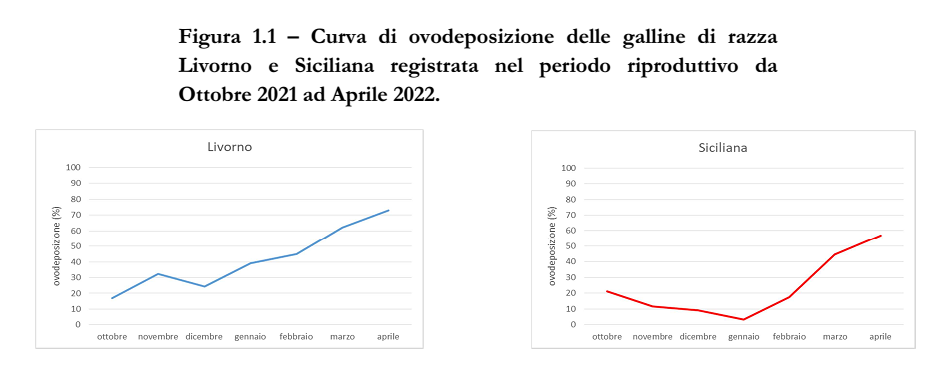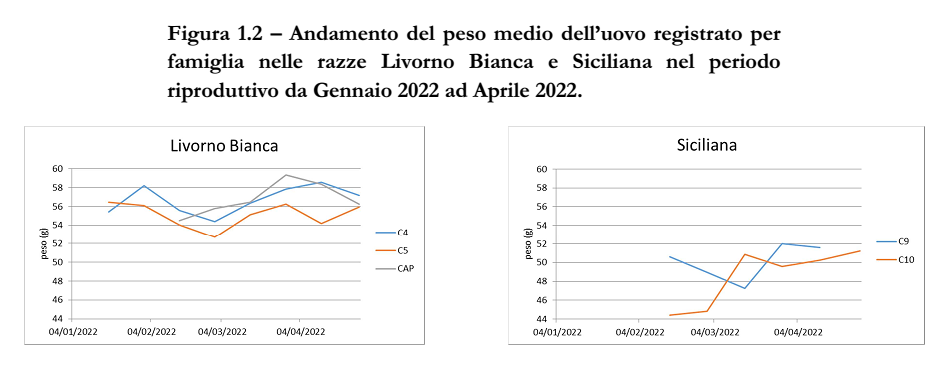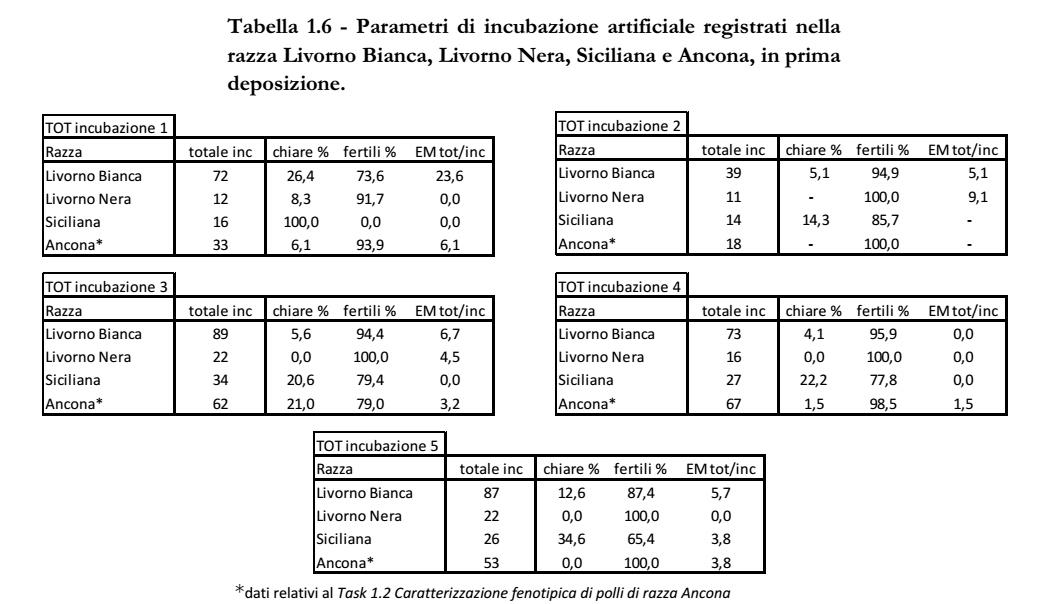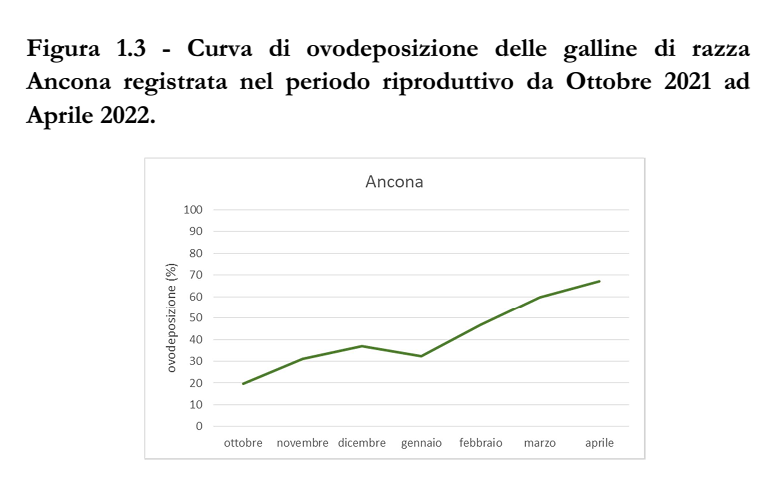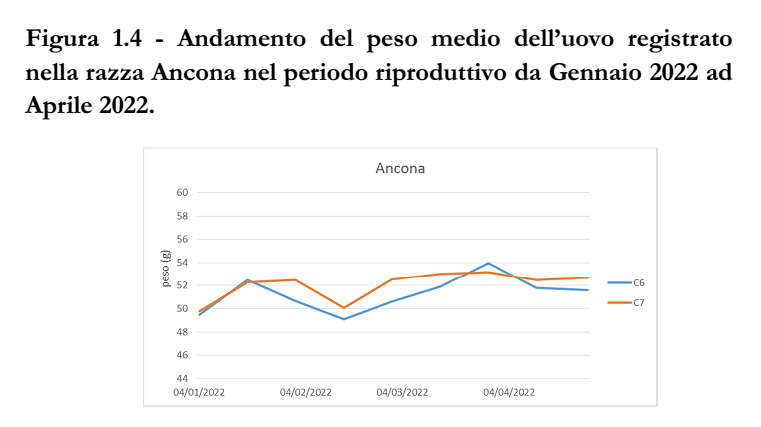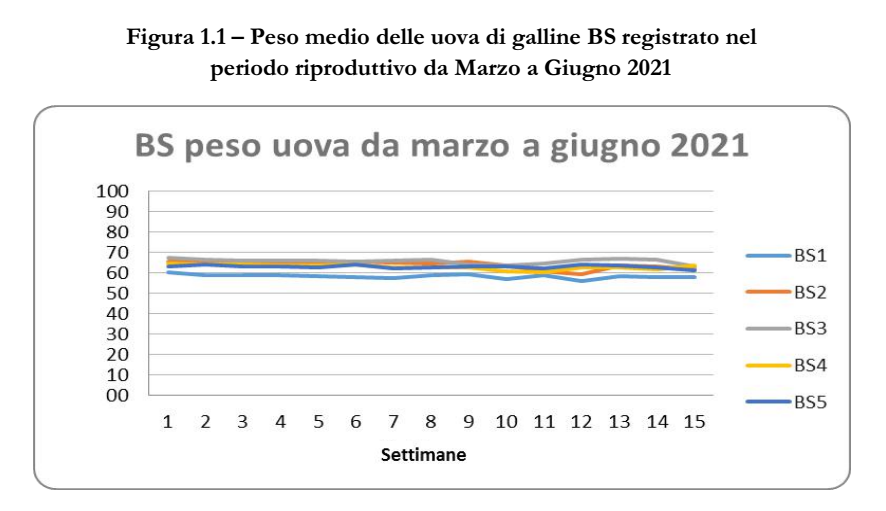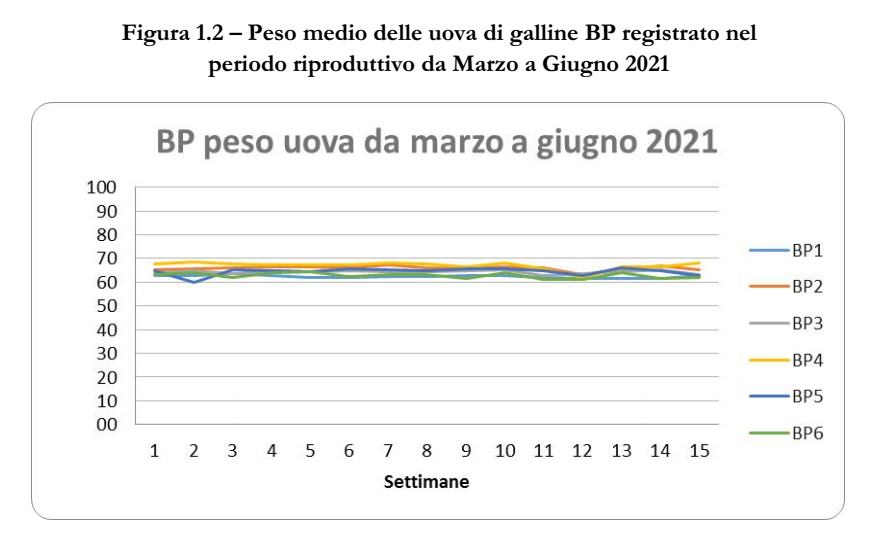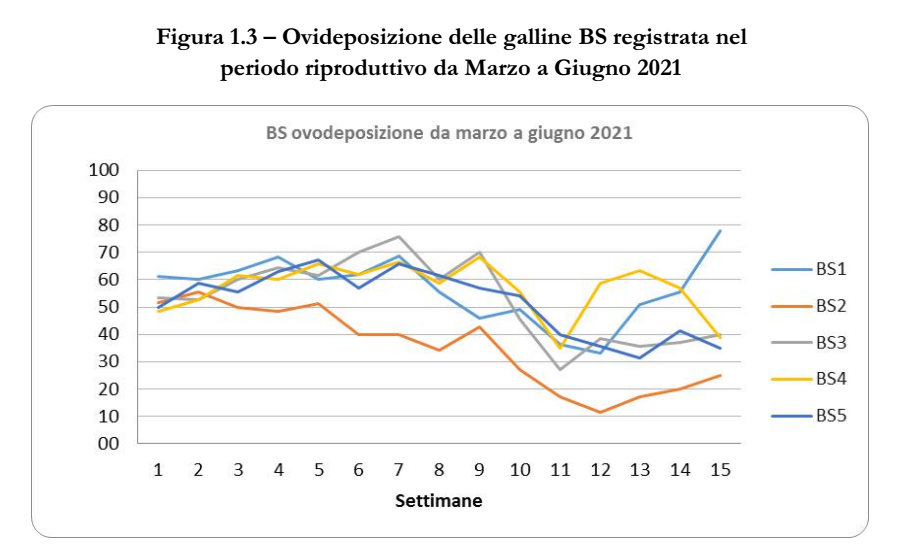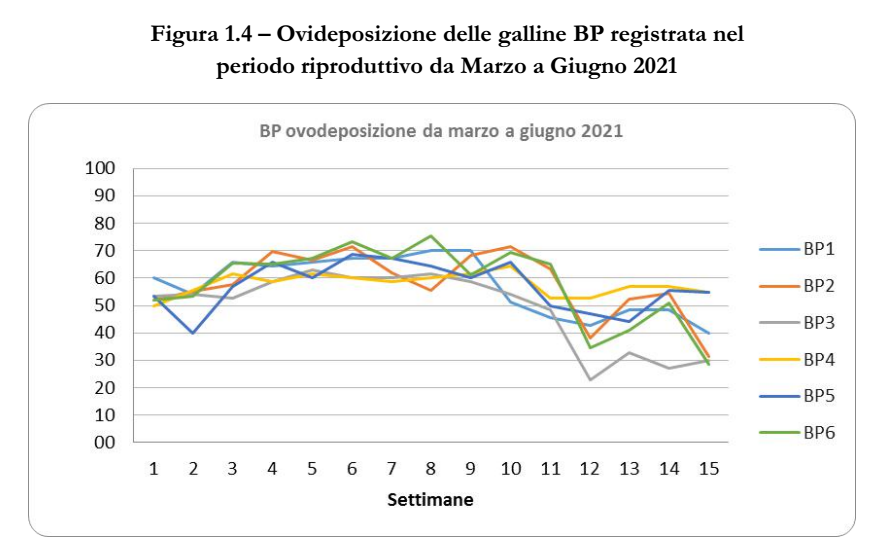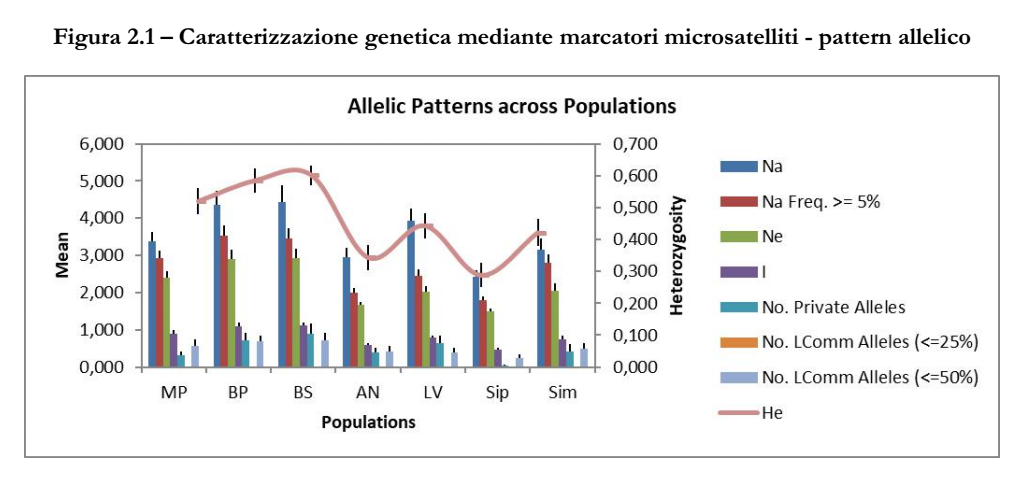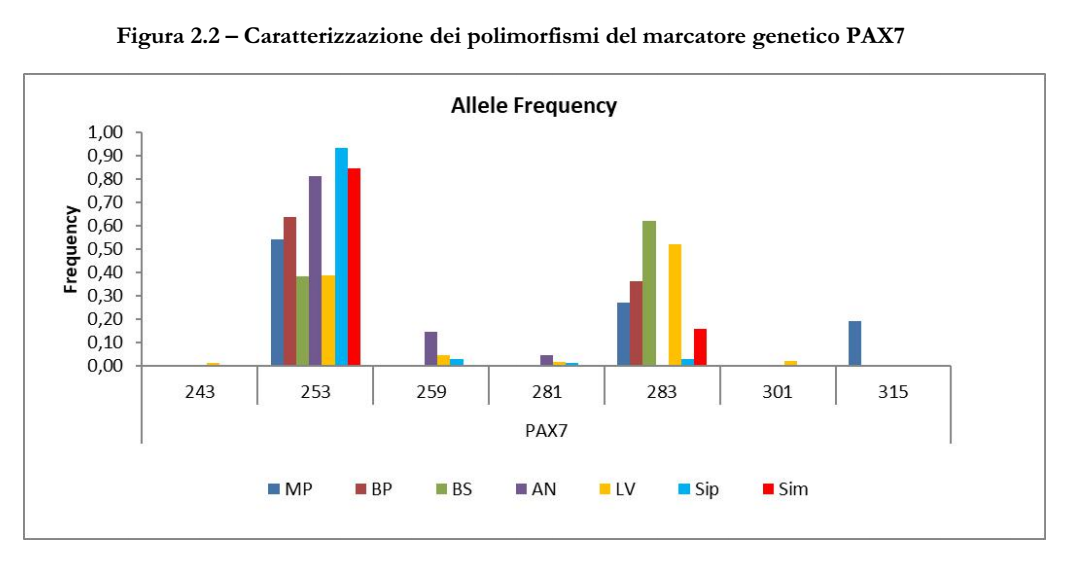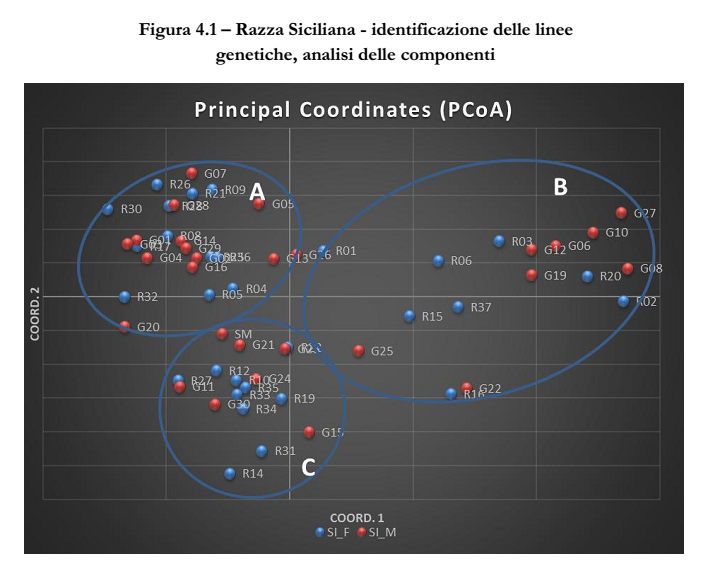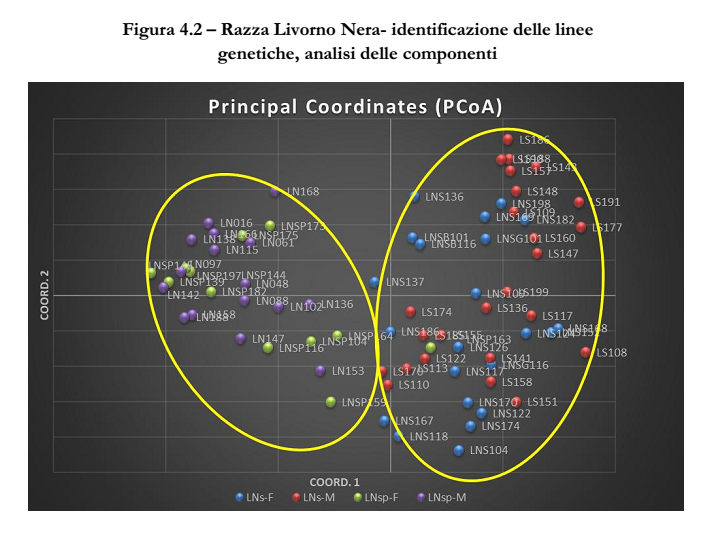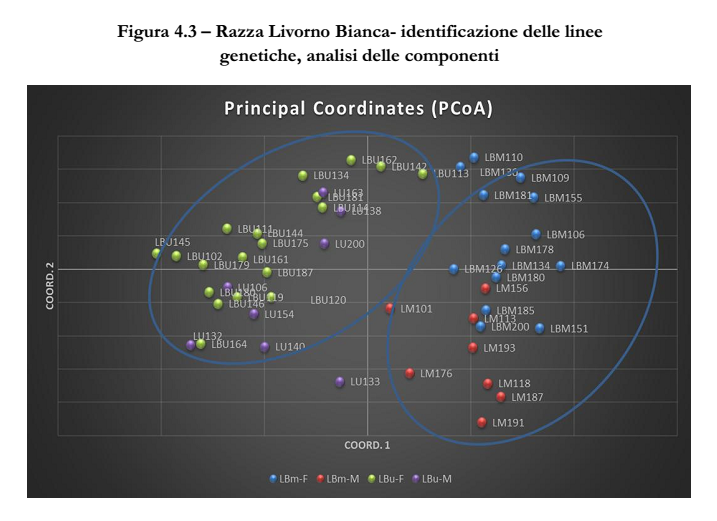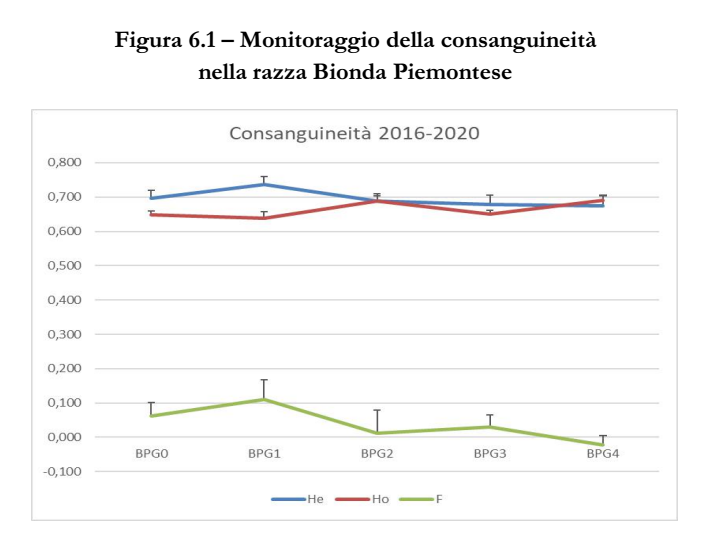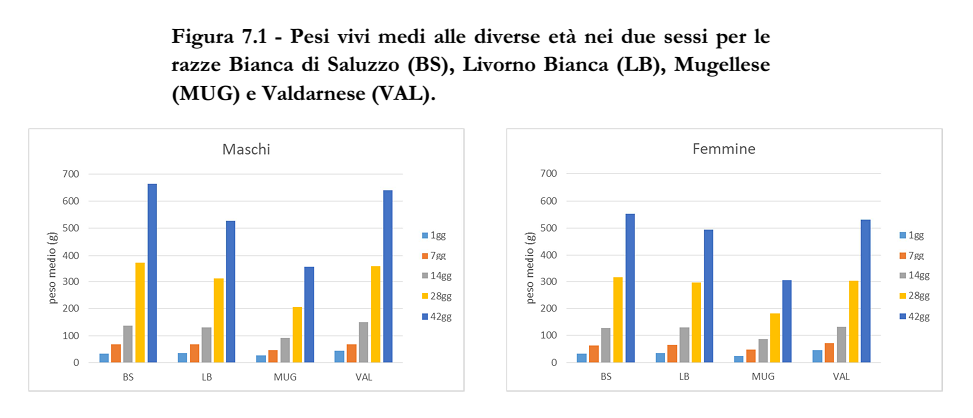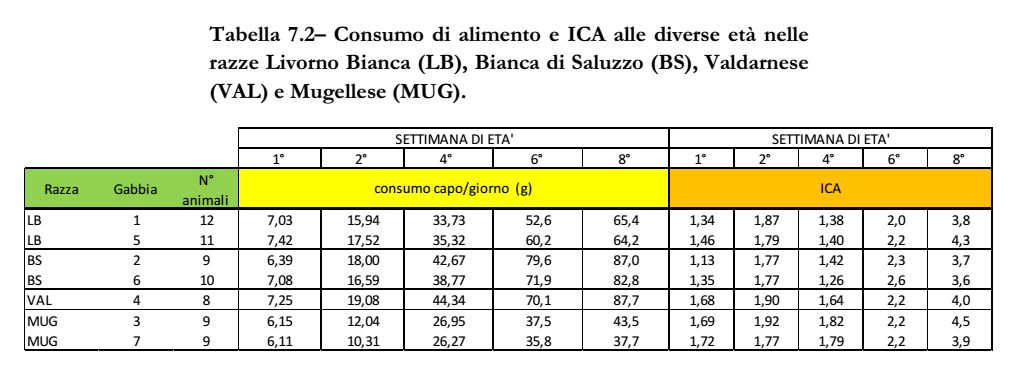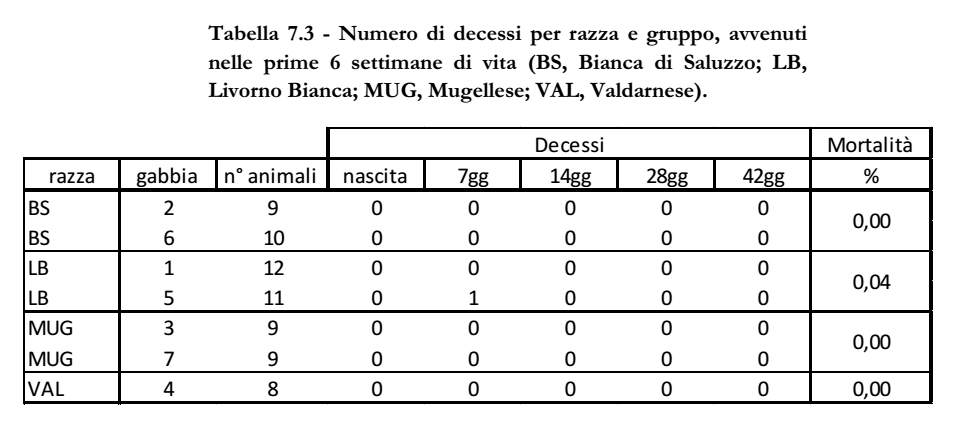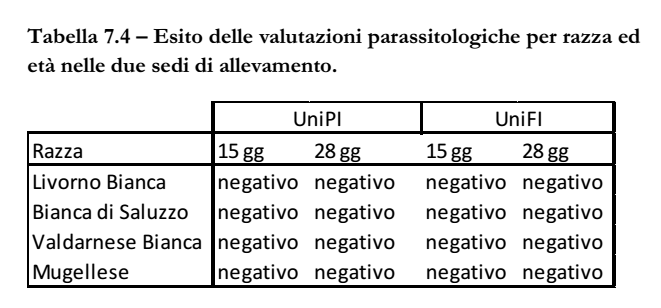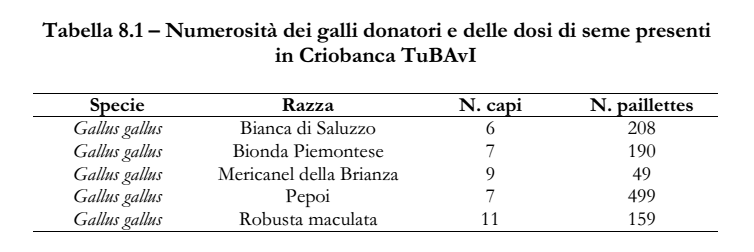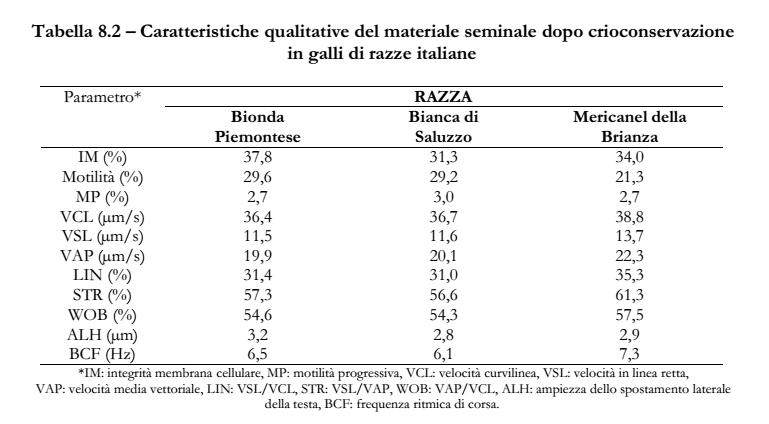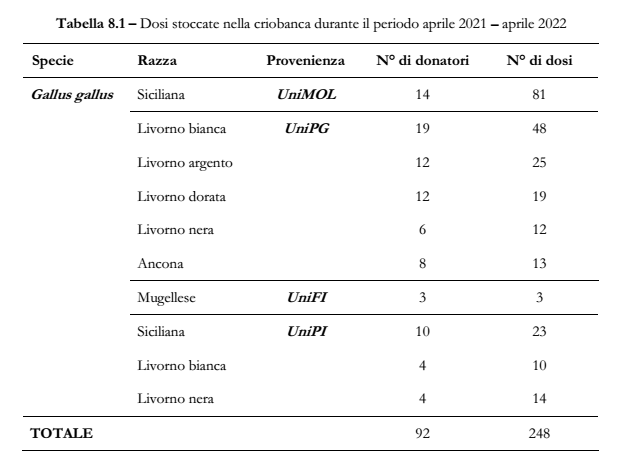Action 1 – Phenotypic characterisation
University of Milan
Phenotipic characterisation of Mericanel della Brianza (MB) chickens Phenotypic traits related to the reproductive performance of the breeder flock reared at the Centro Avicolo per la Conservazione di Risorse Genetiche Locali (Centro Zootecnico Didattico Sperimentale – CZDS, Università degli Studi di Milano, Lodi) have been recorded from April 2021 to May 2022. In April 2021, one year old breeders (n=61) were reared indoor in controlled environment. Breeders were organized in 7 groups, corresponding to different blood lines; each group included one male and a variable number (3-14) of females. Egg oviposition was started on 24 weeks of age (September 2020) and was recorded daily during the first and second year of age; weekly oviposition rate is presented in Figure 1.1. Data show different cycles of oviposition, the first one 51 weeks long and more efficient, and two further cycles shorter and less efficient in the second year of age. Overall egg production is quite limited, being only 36% the oviposition peak reached in the first year of age.
Egg weight was daily recorded and mean egg weight calculated weekly is reported in Figure 1.2. Egg weight constantly increased from 27 to 38 g during the first oviposition cycle, whereas it ranged from 37 to 39 g in the following cycles.
Morphological, according to FAO (2012) guidelines, and behavioural (home pen behaviour and reactivity test) traits were recorded in all breeders. Quantitative morphological variables are reported in Table 1.1.
Fertility and hatchability were recorded in 2 and 4 sets in the first and second year of age respectively. Mean fertility and hatchability values measured in 2021 and 2022 are reported in Table 1.2. MB breed is characterized by low fertility and hatchability values and a further decrease was observed in the second year of age. Total egg production per hen, average fertility and hatchability recorded in each family group in the first year of age (2021) is reported in table 1.3.
Phenotypic characterisation of Modenese (Mo) chickens Following several contacts with farms in Regions Lombardia and Emilia Romagna in order to find chickens of the Modenese breed, eggs were found available for artificial incubation. The hatch of Mo chickens is expected in June. Chickens will be transferred to UniMI facilities and growing performance will be recorded.
Phenotypic characterisation of Nero d’Italia (NI) and Brianzolo (Br) turkeys During the first year, contacts with fancy farms started, in order to find turkeys of the Nero d’Italia and Brianzolo breeds to be housed within UniMI poultry facilities to perform a detailed phenotipic characterization of the breeds.
Phenotypic characterisation of semen in chicken and turkey breeds Semen production was assessed in the following chicken breeds: Mericanel della Brianza (MB, n=24), Bionda Piemontese (BP, n=19), Bianca di Saluzzo (BS, n=18), Pepoi (Pe, n=15) and Robusta Maculata (RM, n=17). Birds were reared indoor in controlled environment and housed in single cages, with the only exception of MB males kept in floor pens because of the bantam size. Morphological, according to FAO (2012) guidelines, and behavioural (reactivity test) traits were recorded in all male breeders. Semen collection was routinely performed twice weekly for 3-5 months: MB, BS and BP breeds from April to June in 2021, Pe and RM breeds from January to May in 2022. Adaptability to semen collection and semen production were very variable among breeds; mean semen volume and concentration recorded in all breeds are reported in Table 1.4. Mean values of quality parameters measured in the ejaculates of all breeds are reported in Table 1.5.
Aliquots of sperm and seminal plasma were prepared and stored at -20°C until proteomic and lipid analyses.
University of Florence
Phenotypic characterization of Mugellese, Valdarnese bianca and Valdarno chickens Mugellese (MU), Valdarnese bianca (VB), and Valdarno (V) breeders have been reared in the experimental farm of Florence University.
The phenotypic selection was carried out by evaluating the general appearance, livery, weight of animals, posture, crest, wattles and earlobes, tarsus and beak and according to FAO guidelines (2012). Then, an evaluation of animal behavior was made, focusing on the typical breed attitudes.
Three families for each breed were identified: 1) specimens more reflecting the standard breed. 2) subjects born in 2021 in line with the standards, 3) subjects of different ages, to be used to maintain the genetic heritage of the breed.
The newborn chicks were identified on the selected specimens: individual chick and adult live-weight; spawning frequency; hatching percentage of incubated eggs; time of reaching the slaughter weight; estimate of feed consumption; mortality in the breeding cycle; morphological assessments; foot injuries, biometrics and assessments of current breed standards; characterization of the annual egg-laying curve and characterization of the analyzed eggs for weight, size, shell weight, albumen and yolk, albumen/yolk ratio and egg shape index. The collected data were entered into a dataset for archiving.
In tables 1.1, 1.2, 1.3, and 1.4, the morphological characteristics of eggs of Mugellese breed chickens relating to the peak position of March 2022 are compared with the data collected during the last TuBAvI project. The data of the oviposition and morphological characteristics of the eggs relating to the years 2021 and 2022 are being processed.
The selection of the breeders and the mating plans carried out during the TuBAvI project and up until today in TuBAvI-2 have led to standardizing the Mugellese breed subjects belonging to the two liveries, as also demonstrated by the data relating to the morphological characteristics of the eggs.
University of Padua
In the first part of the project, the sampling of biological material (blood) of the poultry species/breeds has been performed together with the collection of morphometric measurements (FAO 2012, Phenotypic characterization of animal genetic resources. FAO Animal Production and Health Guidelines), namely: live body weight, body length, shanks length, shanks circumference, wingspan, and sternum circumference.
The morphometric measurements were also associated to qualitative traits such as the skin and shank colours.
The sampling activity set for November-December 2021 and January-February 2022 was postponed to the end of April 2022 due to avian flu in the Veneto region. Thus, to protect the breeds in conservation inside the conservation centres, the access of external people was prohibited. Therefore, the sampling activity started at the end of April 2022. Currently, 136 animals (males and females) of Anatra Germanata Veneta, Anatra Mignon, and Faraona Camosciata have been sampled together with the respective morphometric measurements (Table 1). The UniPD Partner is encountering some issues in finding animals of Oca Padovana and Collo Nudo Italiano; indeed, their presence on the territory is low, and their status close to extinction (DAD-IS, FAO). The UniPD Partner is working to identify centres/farmers holding these species/breeds to meet the aims of the TuBAvI-2 project. Finally, at the beginning of June 2022, 25 animals of Faraona Camosciata will be sampled to complete the sample size declared in the project.
University of Perugia
Phenotypical characterisation and monitoring of the performances of Ancona and Leghorn breeds The Experimental Poultry Centre of the University of Perugia is engaged in the breeding of native Italian breeds (Ancona and Leghorn; White, Black, Golden and Silver) since 1960 in order to promote and maintain chicken biodiversity.
Poultry populations are organised in families with a male to female ratio of 1:8. All animals are kept on permanent litter and in a controlled environment with regard to light, temperature and humidity following the guidelines for poultry farming and animal welfare.
The Experimental Poultry Centre has all the tools (room equipped for incubation and hatching) for the recovery of the genetic source. All animals are subjected to periodic health checks, and to evaluation of reproductive and productive parameters such as spawning, hatching, fertility, chick viability, growth and mortality. In addition, the animals reaching the adult age (34-36 weeks) are subjected to registration of biometric measures (according to FAO guidelines) in order to monitor the compliance with the breed standards.
Currently each breed is organized into two families each consisting of 12-15 females and at least 3 males. All animals are individually identified by a chip which provides information on the age, sex, parentage, weight and other production parameters.
The mean values of the egg-laying and reproduction parameters recorded in the breeds are presented in Table 1.
At hatching, the animals were marked for individual recognition, fed the same diet and monitored for at least 20 weeks. They were weighed individually every 10 days whereas the consumption of food was recorded as group ingestion. The dietary conversion rate was calculated on the basis of individual mean ingestion and weight gain.
The average data of the male and female lines of the breeds reared at the UniPG experimental centre are given in Tables 2 and 3.
Phenotypical characterisation of Robusta Maculata breed During 2021, in collaboration with UniPD, the Robusta Maculata breed was introduced for the purpose of its conservation at the Experimental Poultry Centre of the UniPG.
Characterisation of the adaptation to low-input breeding systems and evaluation of the performances of the native Leghorn breed In order to carry out an exhaustive phenotypical characterisation, we are proceeding to the evaluation of the degree of adaptation to free-range farming systems characterized by low input diets (use of local raw feeds, moderate energy and protein level) and lack of environmental control (temperature, humidity and light). In fact, the animals will be raised in an outdoor system without the control of the environmental parameters, in particular will be evaluated the ability to adapt to conditions of high temperatures (heat-stress) typical of the summer season.
The study protocol of the trial in question was submitted to the opinion of the University Committee of Bioethics, which accepted the request.
For the following experimental test, the eggs of Leghorn breed were incubated in April 2022 with subsequent hatching in March at the Experimental Poultry Centre of UNIPG.
The trial involves the use of 46 hens and 6 males of white Leghorn, the housing is scheduled for the second half of May 2022, at 14 weeks of age.
During the breeding cycle, starting from two weeks after the housing, we will monitor; the live weight and the egg laying performances; all the parameters concerning the number of eggs produced, their weight and size, and feed consumption.
Behavioral Characterisation The behaviour of the same animals will be also characterised. The animal behaviour will be evaluated two weeks after the housing (at 16 weeks of age). The evaluation will be done with the Noldus XT Technology and the compilation of behavioral forms. In addition, for characterising the kinetic behaviour and adaptability to the farming system, individual devices will be applied to the animals. The research unit developed a bib for poultry, which according to some preliminary field tests, did not interfere with the freedom of movement and with the behavior of the animal. The bibs will be applied to the animals at 14 weeks of age, they have different colors in order to allow the individual identification of the animal. After 3 weeks from the beginning of the trial in the bibs will be inserted a chip equipped with GPS, level meter, MEMS accelerometer and a pedometer that will record the kinetic activity of the chicken. In addition, other behavioural tests will assess in order to evaluate the social interaction between individuals.
University of Molise
Phenotypic characterisation of a Siciliana breed conservation nucleus Siciliana breed chickens (SI) were raised on a farm that had been previously agreed on (Di Iorio Donato farm). All animals were raised outdoors with access to night shelters, following standard guidelines for poultry farming. As part of the activities for the establishment of the SI breed conservation nucleus, 58 individuals (30 females and 28 males) were phenotypically selected. Samples made up of 3-4 intact whole growing feathers were collected from each subject and sent to the Laboratory of Animal Molecular Genetics of the University of Turin for genetic analyses.
The formation of the families took place considering the genetic distances between the females, the males were identified based on molecular relationships. Specifically, three families were formed, each consisting of one male and 8/9 females. Two incubations of SI breed eggs were carried out to verify the level of fertility and hatching; the recorded results are shown in table 1.1. Table 1.2 shows the data relating to the phenotypic characterisation of the SI breed eggs. Activities are underway to evaluate the performance of oviposition and reproduction on a family basis of the following zootechnical parameters: daily oviposition, egg weight, fertility, and hatching.
Evaluation of the productive characteristics of Siciliana breed chickens at a social farm located in Puglia In order to obtain 100 chicks to be sent to a social farm located in Puglia, it is planned to incubate enough eggs starting from May 2022, in at least 2 incubations. The bureaucratic procedures for the identification of the company have also been started.
Phenotypic characterisation of Romagnolo (RO) and Ermellinato di Rovigo (ER) turkeys During the first year various contacts were formed in order to obtain animals or eggs to be incubated to realize a group of breeding animals of the two turkey breeds for phenotypic characterisation and multiplication. The retrieval of the animals is still in progress and mainly concerns the ER breed, while in regards to the RO breed, the incubation of 40 RO eggs purchased from an Emilian breeder is under way.
Phenotypic characterisation for the assessment of innate immunity The aim of the task is to monitor immune resilience on a panel of 7 chicken and 2 turkey native breeds, by measuring some markers of innate immunity: complement, IgY and lysozyme. The collection of blood samples began during the period March-April 2022, in conjunction with the activities for the implementation of the cryobank, carried out at UniPG and UniFI Partners. Specifically, for Livorno and Ancona (UniPG) and for Mugellese and Valdarnese bianca (UniFI), blood was taken from 5 males and 5 females. After coagulation (2 hours at room temperature) the samples were centrifuged at 3000 rpm for 20 minutes and the serum obtained from each subject was aliquoted in 3 or 4 eppendorf and stored at -20 °C. The other breeds involved in this activity are Siciliana (UniMOL), Bianca di Saluzzo and Bionda piemontese (UniMI) for chicken breeds and Romagnolo and Ermellinato di Rovigo for turkey breeds.
Phenotypic characterisation of fresh semen This activity involved the assessment of fresh semen quality in native chicken and turkey breeds and was carried out in conjunction with the implementation of the cryobank. The quali-quantitative characteristics considered were the following: semen volume, sperm concentration (hemocytometric chamber), cell membrane integrity (flow cytometer), total and progressive motility and sperm kinetic parameters (CASA method with SCA software). In Table 1.3 the results of the fresh semen quality recorded in native chicken and turkey breeds are reported.
The characterization of the lipid composition and protein profile of the spermatozoa will be carried out in an integrated manner with the Partner UniMI, considering the following breeds: Siciliana for chickens and Romagnolo and Ermellinato di Rovigo for turkeys.
University of Pisa
Phenotypic characterisation of Livorno, Sicilian, Bianca di Saluzzo and Bionda Piemontese chickens The Livorno (L) and Siciliana (S) chicken breeders were reared at the “Podere Le Querciole” Poultry Farm of the Department of Veterinary Sciences of the University of Pisa from January 2021 to April 2022. All the animals were raised on sandy soil in open-air fences with partial roofing and under natural conditions of light and temperature.
In 2021, L (n = 62) and S (n = 23) breeders were organised into 12 and 4 family groups respectively. Ten incubations of eggs from the L and S breeders at the second egg-laying cycle were carried out to verify the level of fertility and hatchability (Tab. 1.1). In April 2021, 125 L and 48 S chicks hatched; they were the result of the mating plan the PA UniTO proposed to UniPI during the previous TuBAVI project. Chicks were monitored for growth (Tab. 1.2) and mortality (Tab. 1.3) from birth to adulthood and for adult morphological characterisation (Tab.1.4) according to FAO guidelines (2012).
The young hens (L=72 e S=30) were monitored as follows: the age at the onset of egg-laying (it occurred at 23 and 22 weeks of age for L and S, respectively), the daily egg production starting from October 2021 (Fig. 1.1), the average egg-weight starting from January 2022 (Fig.1.2) and the feed consumption for 14 days in April (Tab. 1.5). From February 2022 to April 2022, five egg incubations were carried out to verify the fertility level of the L and S breeders at the first egg-laying cycle (Tab. 1.6).
The young males were selected on morphological and genetics bases and destined for reproductive activity in 2023 season. In 2022, these cocks (23 L and 11 S) were managed for semen collection and trained to abdominal massage starting from February: a favorable response to the massage resulted in 62.5 % white L, 60 % black L and 100 % S.
During the first year, UniPI started the collaboration with UniTO to perform the phenotypic characterisation of Piedmont breeds (Bionda Piemontese and Bianca di Saluzzo), conserved at the Center for the Conservation Local Poultry Genetic Resources, where animals are farmed.
Phenotypic characterisations of Ancona chickens At April 2021, 41 chicks hatched from the Ancona (A) nucleus preserved at UniPI and their growth was monitored. Live weight and mortality during growth, and biometric assessments at adulthood are reported in Tables 1.2, 1.3 and 1.4, respectively. It was recorded the onset of egg-laying occurred at 23 weeks of age and the daily egg production starting from October 2021 (Fig. 1.1), the average egg weight since January 2022 (Fig.1.2)
and the feed consumption for 14 days in April (Tab. 1.5) were recorded. Five egg incubations were carried out to determine fertility data of A breeders at the first egg-laying cycle (Tab. 1.6).
Characterisation of the adaptability of laying hens to seasonal environmental stresses The activity to plan the evaluation of L and S eggs from hens at the first reproductive season started in November 2021. Physical assessments were the weight and dimensions of the egg, the weight of the three egg-components and the shell thickness; the chemical evaluations concerned the yolk and albumen proximate analyses. From January to April, 98 eggs for L and 56 eggs for S were analysed.
University of Turin
Phenotypic characterization of chickens of Bianca di Saluzzo and Bionda Piemontese breed Chicken breeders of Bianca di Saluzzo (BS) and Bionda Piemontese (BP) bred at the Center for the Conservation of Local Avian Genetic Resources (Interdepartmental Centre PRISAn DSV-DISAFA) from July 2021 to May 2022 were in the third breeding cycle. BP breeders (n=80) present in April 2021, were organized in 6 family groups, while BS breeders (n=70) were organized in 5 family groups. Egg production and weight were recorded daily from March to June 2021. The data were assembled weekly and results are reported from Figure 1.1 to 1.4. The chicks hatched from the mating plans in August 2021 (n= 240) have been destined for the selection of breeding heifers. All the animals were bred on land on permanent litter in a controlled environment following standard guidelines for poultry breeding. The individual live weight was recorded every 4 weeks for 5 months. Males were sampled (pens) for genetic analysis. The females were selected in April 2022 on the base of family line (12 per family line) and morphological characteristics. The selection of males will be carried out in June on the basis of genetic indices of individual variability and familial parentage resulting from genetic analysis as well as morphological characteristics. The sexual maturity of the females occurred in correspondence of the 20th week of life (December 2021) and it is in progress the recording of their egg production and weight. Health tests for salmonellosis monitoring shall be carried out regularly.
Activities within Action 1 were performed as a consultant for Partner UniPI.
Action 2 – Genetic characterisation
University of Milan
Sequencing of genome in Meleagris gallopavo species The aim is to acquire data on genome sequencing in Italian turkey breeds. Samples already collected in the previus TuBAvI project will be used and 30 birds from different breeds have been chosen. The external service for sequencing is planned in the second year of the project.
University of Padua
The Gallus gallus species will be characterized through the Affymetrix 600K chip SNP support, whereas for the other species (Anser anser, Anas plathyrhyncos and Numida meleagris), the UniPD Partner is looking for the best way to characterize them by consulting the scientific literature and the commercial contribution. In case no dedicated SNP arrays will be available, the low-coverage whole genome sequencing will be used.
University of Perugia
Genetic characterisation of Ancona and Leghorn breeds The selection of the breeders selected by UniPG involves the evaluation of phenotypic and genetic characterisation. This activity is in collaboration with UniMI (biological material for genetic typing) and UniMOL (semen collection for the creation of a cryobank). The sampling activity with UniMI will be carried out by July 2022 while the sampling activity with UniMOL was completed in March 2022.
In particular, semen collection was carried out with the following steps:
– September 2021 – October 2021: training of Ancona and Leghorn rooster;
– November 2021: first collection and evaluation of semen in collaboration with UniMOL;
– December 2021- February 2022: selection of male donors and maintenance of semen collection;
– March 2022: second semen collection. Blood sampling of 10 Leghorn chickens (5 males and 5 females) and 10 subjects of Ancona (5 males and 5 females).
Genetic characterisation of native chicken breeds through the study of polymorphisms in candidate genes involved in heat stress response The recovery of biological samples of the first TuBAvI project is being defined with UniPD, with which we are also collaborating for the collection of biological samples from the two new breeds (Collo nudo Italiana and Millefiori Piemontese).
Moreover, the sampling of the new breeds raised at the experimental section of UniPG is foreseen, that will increase the final dataset of animals. The same collection of biological material will be sent to UniMI for genetic characterization with microsatellites in order to identify the best breeders, limit the degree of inbreeding and better fix the breed characters (see previous task).
University of Turin
Genetic characterisation using microsatellite markers The aim of the genetic characterisation with microsatellite markers is providing a useful tool for the conservation of biodiversity in nucleus populations managed by the PA semen cryobank. In particular, the following objectives are considered: 1) to identify male candidates for recovery and semen production; 2) to characterise new genetic lines in breeds in conservation; 3) to characterise new breeds of chicken.
Characterization of male candidates The candidates of 5 breeds present in 3 conservation station, namely in UNIPI (Livorno-LV, Siciliana-SIp) UNIMOL (Siciliana-SIm) and UNITO (Bianca di Saluzzo-BS and Bionda Piemontese-BP), were typed with 26 microsatellite markers (Figure 2.1). Typing data were used to calculate the parentage matrix by evaluating the number of alleles shared for each pair of individuals belonging to the same breed, then both the average kinship between all breeders (P) and the average relationship with family lines (Pf) were calculated. Individual heterozygosis (H-ind) has been calculated for each subject.
Characterisation of new breeds: Millefiori Piemontese During the first year, 4 (four) farms in Piedmont have been identified in which individuals phenotypically corresponding to Millefiori Piemontese were detected. Samples of feathers were taken from 50 subjects and submitted to genetic analysis with microsatellite markers. 3 alleles per locus (figure 2.1) were detected, the heterozygosity was 0.57 (Observed, Ho) and 0.51 (Expected, He). The data will be elaborated for the characterization of the genetic variability and the comparison with the other Italian breeds.
Identification of new genetic lines in chicken breeds LI, AN, MB and SI Feather samples were taken from 38 subjects of the Ancona breed for genetic analysis carried out with microsatellite markers; on average 3 alleles per locus were identified (figure 2.1), the was 0.32 (Observed, Ho) 0.34 (Expected, He). The data will be elaborated for the characterisation of the genetic variability and the comparison with the other characterised populations.
Characterisation of polymorphisms of genetic markers in linkage with candidate genes (GAS) The polymorphism of the PAX 7 gene has been characterised in 381 subjects from 7 populations and 7 allelic variants were detected, frequencies are reported in figure 2.2.
Activites within Action 2 were performed as a consultant for Partner UniMI.
Action 4 – Genetic indexes and mating plans
University of Pisa
PA UniPI provided biological samples of own L, S and A preserved nuclei for the estimation of individual genetic indices (H-index and Pf) of the males thus to select chickens and to plan matings with the aim of preserving biodiversity and limiting the increase in consanguinity in their own populations.
University of Turin
Selection of males for reproduction and production of seminal material In populations with lack of information (Siciliana UNIMOL, Livorno UNIPI) blood lines were identified by typing also the females and were defined the subjects belonging to each genetic line To identify the genetically similar subjects and the different family lines from the family matrix, the matrix of distance between the individuals was calculated. The results of the principal components analysis are reported in Figure 4.1.
Reproductive Management In order to maintain maximum genetic variability, the females of each family from the same genetic line were bread together in the same family group. The selection of breeder was made to preserve the greatest existing variability and considering individual heterozygosity. Mating has been planned between subjects belonging to different blood lines in order to minimize the relationship between the male and the female groups. For each male the average relationship between the female groups and candidate male has been calculated, in order to minimize the rate of consanguinity (F).
Activities within Action 4 were performed as a consultant for Partner UniMI.
Action 6 – Monitoring of genetic diversity
University of Turin
In the Bionda Piemontese breed, the consanguinity monitoring was carried out over the period from 2016 to 2020 in terms of variation of the observed and expected heterozygosity (Ho and He), fixation index (F), analysis of the main components of genetic variability and distribution of individual variability (H-ind). The results are reported in Figure 6.1 in which a reduction of the loss of variability can be observed.
Activities within Action 6 were performed as a consultant for Partner UniMI.
Action 7 – Genetic resistance traits
University of Florence
In this action, the UniFI Partner, in collaboration with the UniPI Partner, began the assessment of the resilience and resistance of the Tuscan Mugellese, Valdarnese Bianca, Valdarno, and Livorno breeds to environmental stresses in terms of animal welfare and resistance to pathogens, using as a marker of information the response of the intestinal microbiota to environmental stresses.
Fifteen subjects belonging to the MU breed and 15 subjects of VB, reared in free-range and fed with the same feed (Monge) in UniFI Partner farm, were sampled for cecal feces. After that, DNA was extracted from the collected samples and sent to the laboratories for sequencing. The work is progress. The hatches of eggs from Livorno Bianca, Bianca di Saluzzo (coming from the UniPI Partner and from the UniTO Partner respectively) and others from VB and MU were incubated and handled. The aim of this activity is to create homogeneous groups of 20 subjects per breed, to be reared in the same conditions either in the UniFI and in the UniPI Partners’ farms. At the end of growth period, samples of cecal feces from each subject will be sampled in both locations for microbiota characterization. Since the birth, all the chicks were weighted, and the feces were collected at 15 days for pathogen research. The test is already in progress and other samplings will be carried out at 28, 60, 90, and 120 days.
University of Pisa
Assessment of resilience for growth to environmental stresses Eggs from Mugellese (MUG) and Valdarnese (VAL) breeds from PA UniFI and eggs from Bianca di Saluzzo (BS) from UniTO, were incubated together with own L eggs in February 2022; the outcome of the incubation is shown in table 7.1. The hatched chicks were raised in cages in a protected environment up to 4 weeks of age then transferred to the ground on litter in open-air environment. Body weights (Fig. 7.1), food consumption
(Tab. 7.2) and mortality (Tab. 7.3) data were recorded.
Assessment of resistance / resilience to bacterial and parasitic infections / infestations and resilience of intestinal microbism Feces samples were collected at 15 and 28 days of age from the growing chicks monitored in task 7.1 as well as from coetaneous chicks from the same breeds raised at the PA UniFI facility, which collaborates in this research. Eight pools of feces per breed (5 birds/pool) were submitted to qualitative and quantitative parasitological evaluations for the search for coccidia (Eimeria spp.), nematodes (ascaridia, capillaries, Heterakis), protozoa (Giarda spp. and Cryptosporidium spp.). The results of the evaluations are shown in table 7.4.
Action 8 – Germplasm collection
University of Milan
Collection of germplasm for the Semen Cryobank The Italian semen cryobank of autochthonous chicken and turkey breeds was implemented and semen collected from the breeds described in action 1 task 1.4 was stored in liquid nitrogen. Semen doses were prepared according to the cryopreservation procedure for chicken semen described in the Cryobank SOP. Male semen donors were selected according to their semen production (both quantity and quality variables). The number of male donors and semen doses stored for each chicken breed is reported in Table 8.1. The quality of MB, BP and BS semen was assessed also after thawing and the mean values of several quality parameters are reported in Table 8.2. The assessment of Pe and RM semen quality after thawing is planned in the second year of the project.
University of Molise
Germplasm collection in the Semen Cryobank of Italian Avian Breeds The activity carried out involved the implementation and updating of the Standard Operating Procedures (SOP) of the Cryobank of the Seed of Italian Poultry Breeds for the publication on the project website and the storage of germplasm of donors belonging to different breeds of the Gallus gallus species. The semen was frozen following the cryopreservation protocol and the guidelines reported in the SOPs. Table 8.1 shows the number of donors and sperm doses stored in the cryobank during the first year.
University of Pisa
PA UniPI has provided biological samples from chicken of the own preservation nuclei to be used for the following purposes: genetic typing to select L, S and A roosters for the highest variability; genetic typing to identify L and S roosters to be trained as donors of semen useful for the Italian poultry breeds semen Cryobank; genetic typing of A nucleus for evaluating the genetic diversity within A breed in the territory.
A UniPI has started the collection of genetic material from L breed in the territory.
PA UniPI maintained, managed and trained 23 L and 11 S roosters to release semen, obtaining 61 % and 100% favorable responses to semen donation for L and S, respectively. UniPI provided semen samples to PA UniMOL, which performed semen evaluation and freezing on April 7-8, 2022.
